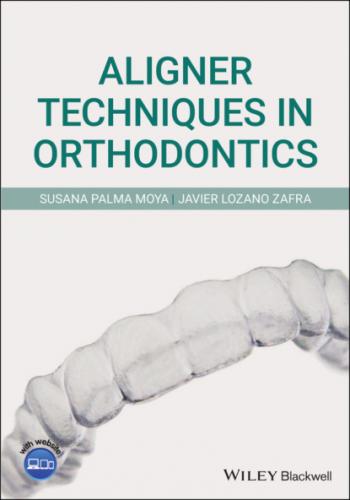9 Chapter 11Fig. 11.1 Dedicate time to setting up clinical preferences.
10 Chapter 12Fig. 12.1 Have materials and equipment ready before any appointment.Fig. 12.2 (a) Place composite on template and (b) ensure there is no composi...Fig. 12.3 A metal interproximal reduction strip is the most common type used...Fig. 12.4 A high‐speed bur interproximal reduction (IPR) is suggested for 0....Fig. 12.5 Interproximal reduction and attachments removal bur set is ideal f...Fig. 12.6 Interproximal reduction has to be carefully planned and performed....
11 Chapter 13Fig. 13.1 Frontal, smile and lateral photographs.Fig. 13.2 90 degrees pictures are mandatory both in right (a) and left (b) i...Fig. 13.3 Intraoral frontal (a) and overjet (b) pictures will help create a ...Fig. 13.4 Blue or red ink on both upper (a) and lower (b) occlusal pictures ...Fig. 13.5 Polyvinyl siloxane (PVS) material placement.Fig. 13.6 Inserting tray with polyvinyl siloxane (PVS) material into the pat...Fig. 13.7 Upper (left) and lower (right) impressions.Fig. 13.8 iTero scanner has several advantages, such as the Outcome Simulato...Fig. 13.9 Lateral and panoramic X‐rays.
12 Chapter 14Fig. 14.1 ClinCheck software on‐screen.Fig. 14.2 Compare ClinCheck with pictures on the same plane before start pla...Fig. 14.3 Distortions of the impression might affect aligner coverage, so it...Fig. 14.4 Anterior view.Fig. 14.5 Overjet view.Fig. 14.6 Buccal right view.Fig. 14.7 Buccal left view.Fig. 14.8 Occlusal view: maxillaryFig. 14.9 Occlusal view: mandibular.Fig. 14.10 Posterior view.Fig. 14.11 Mandibular advancement.Fig. 14.12 Treatment overview helps us understand general structure of the t...Fig. 14.13 Reviewing occlusal views.Fig. 14.14 Analysis of the force vectors: in simultaneous distalization, if ...Fig. 14.15 Anterior positive torque (left) allows pure intrusion to resolve ...Fig. 14.16 The sequence will always be based on three steps: (1) procline in...Fig. 14.17 Staging is mandatory to help achieving desired final position.Fig. 14.18 Checking every stage on anterior sector will prevent from unaesth...Fig. 14.19 Round tooth rotations (canines and premolars) require perfectly s...Fig. 14.20 Ask the technician to perform the extrusion of the canine simulta...Fig. 14.21 The pearl necklace effect explains how to use these mechanics in ...Fig. 14.22 Simultaneous expansion for reduction in arch length (incisor retr...Fig. 14.23 Expansion leads to arch depth loss and anterior retraction.Fig. 14.24 Whenever possible, simultaneous anterior intrusion and posterior ...Fig. 14.25 Superimposition tool.Fig. 14.26 Black dots indicate complex movements.Fig. 14.27 Blue dots indicate moderate movements.Fig. 14.28 Attachments.Fig. 14.29 White boxes indicating interproximal reduction turn yellow at the...Fig. 14.30 Treatment overview also addresses interproximal reduction needs....Fig. 14.31 Buttons and hooks: the biomechanical difference between button cu...Fig. 14.33 Button cutouts will allow composite or metal butons to be bonded ...Fig. 14.34 Upper hook will affect upper anterior torque.Fig. 14.35 Upper cutout for bonded button will have less effect on anterior ...Fig. 14.36 Treatment overview also refers to hooks or button cutouts.
13 Chapter 16Fig. 16.1 An example of poor fitting.Fig. 16.2 Fitting can improve with ‘fitters’ chewing.Fig. 16.3 Detailing pliers are helpful for case finishing.Fig. 16.4 Auxiliary technique to recapture a rotated lower canine with butto...Fig. 16.5 Buccal (left) and palatal (right) view of a lateral incisor extrud...Fig. 16.6 Ectopic canines not covered by the aligner.Fig. 16.7 Uprighting a premolar root.Fig. 16.8 This patient had a distal tipping of the second premolar root. A P...Fig. 16.9 In this case goal was to mesialize 47 and 48 in order to close 46 space.Fig. 16.10 Patient with missing 46.Fig. 16.11 The patient had missing 36 and 46.Fig. 16.12 A Locatelli helps to open space.Fig. 16.13 Temporary anchorage devices help intruding teeth in severe deep b...Fig. 16.14 Posterior extrusion is achieved here with auxiliary buttons and e...Fig. 16.15 Auxiliary buttons and elastics help derotating teeth.Fig. 16.16 Change in smile after expansion of upper arch and offset and rota...Fig. 16.17 Mesial‐in rotation of the canine.Fig. 16.18 Mesial‐out rotation of the canine.Fig. 16.19 Finishing bends.Fig. 16.20 Fixed retention from lateral to lateral.Fig. 16.21 Vivera retainers are manufactured by Align Technology.
14 Chapter 17Fig. 17.1 Interproximal reduction has to be performed carefully in order to ...Fig. 17.2 Interproximal reduction might improve the shape and size of teeth,...Fig. 17.3 Interproximal reduction in cases of crowding might improve contact...Fig. 17.4 Spacing cases are usually related to abnormal tooth size, which le...Fig. 17.5 Palatal root torque is seen on the ClinCheck Pro as blue areas on ...Fig. 17.6 Skeletal class I with spacing.Fig. 17.7 Pretreatment views.Fig. 17.8 Pretreatment panoramic X‐ ray, teleradiograph and cephalometry.Fig. 17.9 Upper CC superimposition and instructions to CAD designer.Fig. 17.10 Lower CC superimposition and instructions to CAD designer.Fig. 17.11 Front CC view.Fig. 17.12 Front intraoral picture.Fig. 17.13 Right ClinCheck view, initial situation.Fig. 17.14 Left ClinCheck view, initial situation.Fig. 17.15 Post‐treatment views.Fig. 17.16 Pretreatment and final smile.Fig. 17.17 Post‐treatment panoramic and lateral X‐rays.Fig. 17.18 Skeletal class I with spacing.Fig. 17.19 Intraoral views left, front, right, upper, lower.Fig. 17.20 Smile and pretreatment panoramic X‐ray.Fig. 17.21 Pretreatment Clinchecks.Fig. 17.22 Refinement: intraoral views, left, front, and rightFig. 17.23 Refinement ClinChecks.Fig. 17.24 Final intraoral views left, front, right, upper, lower.Fig. 17.25 Before and after smile.Fig. 17.26 Final panoramic and lateral X‐rays.Fig. 17.27 Skeletal class III with upper maxillary compression and anterior ...Fig. 17.28 Pretreatment views.Fig. 17.29 Pretreatment panoramic X‐ray, teleradiograph and cephalometry.Fig. 17.30 Planned IPR on midline can be seen in several areas of the ClinCh...Fig. 17.31 Upper CC superimposition and instructions to CAD designer.Fig. 17.32 Lower CC superimposition and instructions to CAD designer.Fig. 17.33 Right ClinCheck view, initial situation.Fig. 17.34 Left ClinCheck view, initial situation.Fig. 17.35 Post‐treatment images (right, front, left, upper, lower).Fig. 17.36 Pretreatment smile.Fig. 17.37 Final smile.Fig. 17.38 Upper crowding and anterior crossbite ‘Lite’ treatment in a class...Fig. 17.39 Pretreatment extraoral and intraoral (right, front, left, upper, ...Fig. 17.40 Pretreatment panoramic X‐ray, teleradiograph and cephalometry.Fig. 17.41 Upper CC superimposition and instructions to CAD designer.Fig. 17.42 Lower CC superimposition and instructions to CAD designer.Fig. 17.43 Right ClinCheck view, initial situation.Fig. 17.44 Left ClinCheck view, initial situation. Fig. 17.45 Planned IPR on midline can be seen in several areas of the ClinCh...Fig. 17.46 Initial intraoral views.Fig. 17.47 Final intraoral views.Fig. 17.48 Initial and final occlusal (upper and lower).Fig. 17.49 Pretreatment smile and overjet.Fig. 17.50 Final
